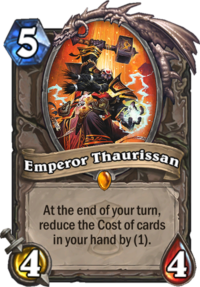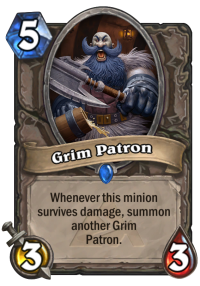After defeating Kel’thuzad and spending some time with various goblins and gnomes, the Hearthstone community took a visit to Blackrock Mountain, meddling with the affairs of Lord Victor Nefarian and Ragnaros the Firelord to unlock a bunch of useless Dragons and then EVERYONE GOT IN HERE. In retrospect, it’s more of the same, little more than a reskin of the Naxx experience – but a competent enough one with a few memorable enough encounters to make worth a quick revisit even after all these years.
Check out other parts of the series:
♫♪♫ BLACKROCK MOUNTAIN! A HEARTHSTONE ADVENTURE! ♫♪♫
Blackrock Mountain (or BRM for short) was Hearthstone’s second adventure and even its biggest fans would probably concede that it hasn’t done a lot to innovate on the extremely successful format of the Curse of Naxxramas. Disappointingly, most of the boss cards are just stat piles this time around, adding to the feeling that this adventure is more of a rehash than its own standalone creation. It has, however, brought along two unique and meta-defining Neutral cards and a keyword (of sorts) which stood the test of time even if the initial cards using it were way too underpowered. It’s just that the Dragons themselves never really made any sort of impact.
I would have to rate this the worst trailer, unless you like really enjoy the art on Demonwrath. There is no catchy song and the animations are all just fiery. Please remake this trailer blizzerd with ragnaros singing a catchy tune – /u/Woofbowwow
The solo experience was ultimately quite similar to Naxx’s, with five wings of encounters and the corresponding class challenges pitting you against the foes on the mountain. First it’s the perfectly legit and not at all obvious bad guy Lord Victor Nefarian who’s asking you to depose of Ragnaros, a character already familiar to players thanks to his omnipresence in control decks at the time. Dealing with Majordomo Executus to summon the Firelord is one of the most memorable adventure encounters from the era, and a continuation of the two-stage boss design we’ve seen with KT. Except, you know, for the part where the snarky lich didn’t hold four Molten Giants in hand waiting to play them out just before you beat the first stage of the boss. Unsurprisingly, at least to the genre savvy players out there, we keep going after Ragnaros is banished to deal with the rest of the baddies on the mountain, including Nefarian across two separate battles, where the not-quite-dead Ragnaros is more than happy to exact some revenge, and their tussle eventually became the foundation of the very first Tavern Brawl in the game.
At least on Normal mode.
It goes to show that Heroic Mode was still actively referenced by the characters in the context of the game at this stage, much like how KT obliterated your Alexstrasza on play. Battles like the Heroic Emperor Thaurissan encounter where you have to keep the wife alive to avoid triggering the “deal 30 damage” hero power are a bit annoying because of the boss’ tendency to damage its own minions but at least it maintains a unique flavor in its own right. Not that the encounters revolving around resource generation retain any sort of challenge these days: even a neutered version of Galakrond Priest can get you through the first encounter with Nefarian (I did it without using its Hero Power a single time), and though I did have to resort to generating the extra cards in the actual final Heroic encounter, I didn’t exactly break a sweat. Once you consider how Nefarian’s own hero power also generates extra resources (either random spells or minions depending on the encounter), you could make a decent argument that this was the first time we really got to see the modern imagining of Hearthstone in action where long games were not about grinding down a set or finite resources in an efficient manner but drowning the opponent in a metric volume of crap until they collapse from exhaustion.
I wouldn’t concede just yet, Blizzard’s next level AI might just trade everything into your lightwell anyway – /u/Fuzati
The Dragons’ Hoard
Interestingly, the gameplay implications of the BRM adventure cards had very little to do with the most-hypoed aspect of the adventure: it promised to add Dragon synergies to the mix, with the “if you’re holding a Dragon” card text supposed to reward you for essentially having to hold a dead card in your hand for a given amount of turns, plus a batch of cheaper tribe cards. In Classic, only Faerie Dragon and Twilight Drake cost less than nine, meaning any sort of tribal synergy had to be built from the ground up. The first attempts weren’t successful: the payoffs were way too conservative and the Dragons themselves were also not powerful enough, especially once you consider the other additions that came in the set.

The fact that Hunter and its hyper-aggressive strategies got Quick Shot seemed ridiculous even at the time and doesn’t look any better today. Flamewaker, Revenge, Imp Gang Boss and Twilight Whelp remain as the other standout class cards from the period (with Gang Up, Dragon's Breath, Demonwrath and Resurrect eventually finding some space as well), making BRM a mixed bag from this perspective. With most Dragon-related neutrals from the adventure ending up as duds and Majordomo Executus being little more than an exciting meme better left off to 200 IQ players like dog, it took two very specific cards to cement the enduring legacy of BRM and a permanent imprint on the Constructed metagame. It’s no mistake they both broke the math of Hearthstone: Emperor Thaurissan’s impact goes without saying, especially in the context of any combo finisher (most notably the old Force of Nature+Savage Roar combo whose damage potential suddenly spiked from 14 to 22).
Then there’s the other one.

The core of the Grim Patron deck was not that difficult to figure out. In fact, it was basically pre-packaged for us in the Warrior class challenge of the adventure, albeit an unoptimized build and one which quite literally couldn’t be built in the game as it features extra copies of cards like Axe Flinger, Warbot and Dragon Egg, none of which would make the final build in Constructed. It was also missing Warsong Commander, which gave Charge to any minion with three or less Attack at the time, which itself was a nerf from its original form where it gave Charge to anything, leading Warrior players to OTK with free Molten Giants in the past. Thing is, Frothing Berserker still counted, which, when coupled with Grim Patrons charging into boards and lots of Whirlwind-like effects, basically guaranteed an instant kill from any board state with the right kind of setup. It was a deck with a high skill ceiling but it was also impossible to counter, with Handlock offering your best shot at basically a coinflip at the top levels of play. It was the sort of deck where its pilot had a lot of interesting decisions to make at all times but the opponent had no way to disrupt their approach – again, somewhat similar to many of the popular decks today. Eventually, Warsong Commander was completely obliterated in a nerf, to such an extent you wouldn’t be able to tell what its card text was without the memes.
And yet, as widely derided the nerf choice was, time has proven it to be the correct one. Even if you were to adjust Frothing Berserker instead, the ability to give Charge to minions that shouldn’t have it would inevitably prove problematic over time. Besides, the archetype remained relevant even after the card was flushed down the toilet, even at the following World Championship. In fact, the Charge keyword itself was quietly shelved, with almost every initiative card getting Rush instead.
Similarly, Team 5’s next stab at adventure content turned out to be a much better version of what came before, especially on the card design front.
This is a second part of a series of posts revisiting Hearthstone’s old PvE content. Tune in next time to get the scoop on League of Explorers, how incredibly good the set’s design was and how much better Discover used to be than it is today.


Missing the end of a sentence, I think.
> the “deal 30 damage” hero power are a bit Not that the encounters
Whoops, thanks for pointing this out! 🙂
Nice review. Olf times bro. 🙂